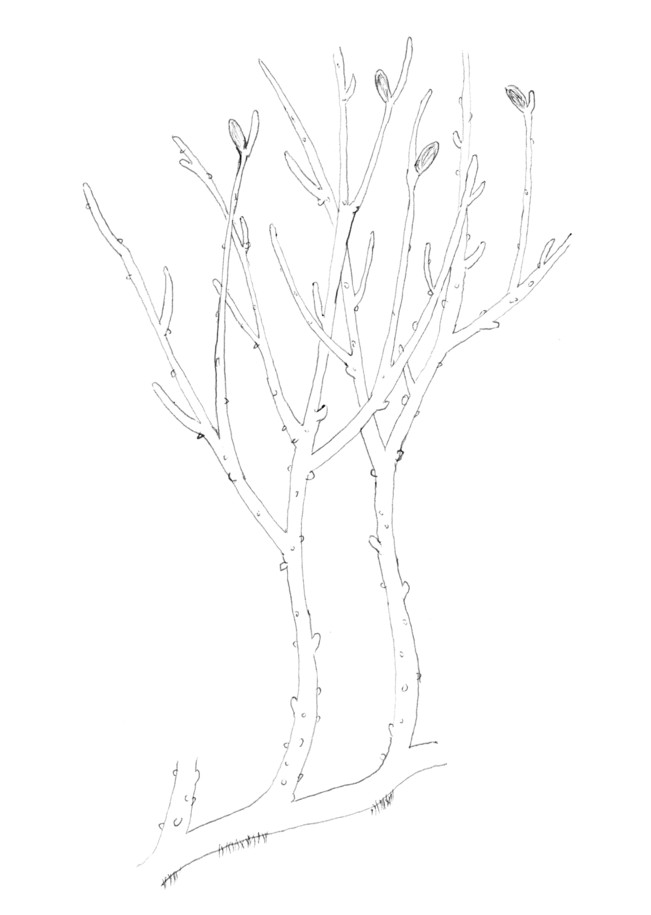- Rhynia
Taxobox
fossil_range = EarlyDevonian

image_caption = Reconstruction of "Rhynia gwynne-vaughanii", redrawn afterP. Kenrick, P.R. Crane (1997) The origin and early diversification of land plants. A cladistic study. Smithsonian Institution Press, Washington & London, ISBN 1-56098-729-4. Fig. 4.8, p. 101.]
image_width=150px
regnum =Plant ae
divisio =Rhyniophyta
classis =Rhyniopsida
ordo =Rhyniales
familia =Rhyniaceae
genus = "Rhynia"
genus_authority = Kidston & Lang (1917)
species = "R. gwynne-vaughanii"
binomial = "Rhynia gwynne-vaughanii"
binomial_authority = Kidston & Lang (1917)"Rhynia gwynne-vaughanii" was the
sporophyte Edwards, DS (1980) Evidence for the sporophytic status of the Lower Devonian plant "Rhynia gwynne-vaughanii" Kidston and Lang. Review of Palaeobotany and Palynology, 29, 177-188] generation of a vascular, axial, free-sporing diplohaplontic embryophytic land plant of the LowerDevonian that had anatomical features more advanced than those of thebryophyte s, and was basal to modernvascular plants or eutracheophytes."R. gwynne-vaughanii" was first described as a new species by Kidston and Lang in 1917.R. Kidston and W.H. Lang (1917) On Old Red Sandstone plants showing structure from the Rhynie chert bed, Aberdeenshire. Part I. "Rhynia gwynne-vaughanii", Kidston and Lang. Transactions of the Royal Society of Edinburgh, 5, 761-784.] The species is known only from the
Rhynie chert inAberdeenshire ,Scotland , where it grew in the vicinity of asilica -richhot spring . "Rhynia" was a vascular plant, and grew in association with other vascular plants such as "Asteroxylon mackei", a probable ancestor of modernclubmoss es (Lycopsida ), and with pre-vascular plants such as "Aglaophyton major ", which is interpreted as basal to true vascular plants.D.S. Edwards (1986) "Aglaophyton major", a non-vascular land-plant from the Devonian Rhynie chert. Botanical Journal of the Linnean Society, 93- 173-204.]"Rhynia" is thought to have had wict|deciduous lateral branches, which it used to disperse laterally over the substratecite journal
author = Bateman, R.M.
coauthors = Crane, P.R.; Dimichele, W.A.; Kenrick, P.R.; Rowe, N.P.; Speck, T.; Stein, W.E.
year = 1998
title = EARLY EVOLUTION OF LAND PLANTS: Phylogeny, Physiology, and Ecology of the Primary Terrestrial Radiation
journal = Annual Reviews in Ecology and Systematics
volume = 29
issue = 1
pages = 263-292
doi = 10.1146/annurev.ecolsys.29.1.263] [cite journal|author= Edwards DS|year= 1980|title= Evidence for the sporophyte status of the Lower Devonian plant "Rhynia gwynne-vaughnii" Kidston and Lang|journal=Rev. Palaeobot. Palynol|volume=29|pages=177–188|doi=10.1016/0034-6667(80)90057-3] and stands of the plant may therefore have been clonal populations.Evidence of the
gametophyte generation of "Rhynia" has been described in the form of crowded tufts of diminutive stems only a few mm in height, with the form genus name "Remyophyton delicatum".H. Kerp, N.H. Trewin and H. Hass (2004) New gametophytes from the Early Devonian Rhynie chert. Transactions of the Royal Society of Edinburgh, Earth Sciences, 94, 411–428] Like those of "Aglaophyton major",Remy, W. & Hass, H. 1996. New information on gametophytes and sporophytes of "Aglaophyton major" and inferences about possible environmental adaptations. Review of Palaeobotany and Palynology 90, 175–93.] Remy, W. & Remy, R. 1980. "Lyonophyton rhyniensis" n. gen. et nov. spec., ein Gametophyt aus dem Chert von Rhynie (Unterdevon,Schottland). Argumenta Palaeobotanica 6, 37–72.] "Horneophyton lignieri"Remy, W. & Hass, H. 1991a. "Langiophyton mackiei" nov. gen., nov. spec., ein Gametophyt mit Archegoniophoren aus dem Chert von Rhynie (Unterdevon Schottland). Argumenta Palaeobotanica 8, 69–117.] and "Nothia aphylla"Remy, W. & Hass, H. 1991b. "Kidstonophyton discoides" nov. gen. nov. spec., ein Gametophyt aus dem Chert von Rhynie (Unterdevon, Schottland). Argumenta Palaeobotanica 8, 29–45] the gametophytes of "Rhynia" aredioicous , bearing male and female gametangia (antheridia and archegonia) on different axes. A significant finding is that the axes were vascular, unlike almost all of the gametophytes of modern pteridophytes except for that ofPsilotum . Holloway, J.E. 1939. The gametophyte, embryo and young rhizome of "Psilotum triquetrum" Schwarz. Annals of Botany 3, 313-336]References
Wikimedia Foundation. 2010.
